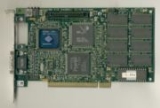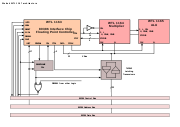
Weitek
Encyclopedia


Microprocessor
A microprocessor incorporates the functions of a computer's central processing unit on a single integrated circuit, or at most a few integrated circuits. It is a multipurpose, programmable device that accepts digital data as input, processes it according to instructions stored in its memory, and...
-design company that originally concentrated on floating point unit
Floating point unit
A floating-point unit is a part of a computer system specially designed to carry out operations on floating point numbers. Typical operations are addition, subtraction, multiplication, division, and square root...
s for a number of commercial CPU
Central processing unit
The central processing unit is the portion of a computer system that carries out the instructions of a computer program, to perform the basic arithmetical, logical, and input/output operations of the system. The CPU plays a role somewhat analogous to the brain in the computer. The term has been in...
designs. During the early to mid-1980s, Weitek designs could be found powering a number of high-end designs and parallel processing
Parallel processing
Parallel processing is the ability to carry out multiple operations or tasks simultaneously. The term is used in the contexts of both human cognition, particularly in the ability of the brain to simultaneously process incoming stimuli, and in parallel computing by machines.-Parallel processing by...
supercomputer
Supercomputer
A supercomputer is a computer at the frontline of current processing capacity, particularly speed of calculation.Supercomputers are used for highly calculation-intensive tasks such as problems including quantum physics, weather forecasting, climate research, molecular modeling A supercomputer is a...
s. During the early 1990s most CPU designs started including FPUs built-into the system, basically “for free”, and Weitek made a series of attempts to break into the general CPU and graphics driver market. By 1995 the company was almost dead, and in late 1996 the remains were purchased by Rockwell
Conexant
Conexant Systems, Inc. is an American semiconductor company, formerly the semiconductor division of Rockwell International. Currently it's privately owned by Golden Gate Capital, an equity firm headquartered in San Francisco.-History:...
's Semiconductor Systems and quickly disappeared.
Weitek started in 1981, when several Intel engineers left to form their own company. Weitek developed math coprocessors for several systems, including those based on the Motorola
Motorola
Motorola, Inc. was an American multinational telecommunications company based in Schaumburg, Illinois, which was eventually divided into two independent public companies, Motorola Mobility and Motorola Solutions on January 4, 2011, after losing $4.3 billion from 2007 to 2009...
68000 family, the 1064, and for Intel based i286 systems, the 1067. Intel's own FPU design for the i386 fell far behind in development, and Weitek delivered the 1167 for them. Later upgrades to this design led to the 2167, 3167 and 4167. Weitek would later deliver similar FPUs for the MIPS architecture
MIPS architecture
MIPS is a reduced instruction set computer instruction set architecture developed by MIPS Technologies . The early MIPS architectures were 32-bit, and later versions were 64-bit...
, known as the XL line. Weitek FPUs were somewhat odd, supporting single precision math only, although doing so at very fast speeds.
As orders increased for supercomputer applications, Weitek found themselves seriously disadvantaged by their fab, which was becoming rather “outdated”. HP
Hewlett-Packard
Hewlett-Packard Company or HP is an American multinational information technology corporation headquartered in Palo Alto, California, USA that provides products, technologies, softwares, solutions and services to consumers, small- and medium-sized businesses and large enterprises, including...
approached them with a deal to use their newer fabs. This proved advantageous for both, and soon HP’s fabs were open to anyone. Weitek also worked with HP on the design of their latest PA-RISC
PA-RISC
PA-RISC is an instruction set architecture developed by Hewlett-Packard. As the name implies, it is a reduced instruction set computer architecture, where the PA stands for Precision Architecture...
design, and sold their own version known as the RISC 8200 which was sold as an embedded
Embedded system
An embedded system is a computer system designed for specific control functions within a larger system. often with real-time computing constraints. It is embedded as part of a complete device often including hardware and mechanical parts. By contrast, a general-purpose computer, such as a personal...
design and had some use in laser printer
Laser printer
A laser printer is a common type of computer printer that rapidly produces high quality text and graphics on plain paper. As with digital photocopiers and multifunction printers , laser printers employ a xerographic printing process, but differ from analog photocopiers in that the image is produced...
s.
In the late 1980s Weitek saw a new opportunity, and started developing frame buffers for Sun Microsystems
Sun Microsystems
Sun Microsystems, Inc. was a company that sold :computers, computer components, :computer software, and :information technology services. Sun was founded on February 24, 1982...
workstation
Workstation
A workstation is a high-end microcomputer designed for technical or scientific applications. Intended primarily to be used by one person at a time, they are commonly connected to a local area network and run multi-user operating systems...
s. In the early 1990s they also introduced the SPARC POWER µP (as in “power-up”, and technically referred to as WTL 8601), a pin-compatible version of the SPARC
SPARC
SPARC is a RISC instruction set architecture developed by Sun Microsystems and introduced in mid-1987....
processor. The µP could be dropped into existing SPARCstation
SPARCstation
The SPARCstation, SPARCserver and SPARCcenter product lines were a series of SPARC-based computer workstations and servers in desktop, deskside and rack-based form factor developed and sold by Sun Microsystems...
2 workstations and ran at 40 MHz, about 50 % faster than the CPUs it replaced. The 8701 ran twice as fast internally, providing a boost of about 50-60 % in overall speed, due to the bus not getting any faster. However they did not pursue this concept with later generations of SPARC processors.
Weitek turned their frame-buffer experience to the PC market in the early 90s, and introduced a series of SVGA multimedia chipsets known as the “POWER” systems. Consisting of two chips, one drawing the graphics known as the P9000 and another handling the output, the VideoPower 5x86, the POWER series was used in a number of 3rd party designs based on the VESA Local Bus
VESA Local Bus
The VESA Local Bus was mostly used in personal computers. VESA Local Bus worked alongside the ISA bus; it acted as a high-speed conduit for memory-mapped I/O and DMA, while the ISA bus handled interrupts and port-mapped I/O.-Historical overview:In the early 1990s, the I/O bandwidth of...
standard. The P9001 moved to PCI
Peripheral Component Interconnect
Conventional PCI is a computer bus for attaching hardware devices in a computer...
and became fairly popular in 1994, known as the Viper in designs from Diamond
Diamond Multimedia
Diamond Multimedia is a company that specializes in many forms of multimedia technology. They have produced graphics cards, motherboards, modems, sound cards and MP3 players, however the company began with the production of the TrackStar, a PC add-on card which emulated Apple II computers...
and Orchid
Orchid Technology
Orchid Technology was a privately held company founded by Le Nhon Bui in 1982. The company's original flagship product was its PCNet card, a 1 megabit-per-second LAN card for IBM PCs and clones. Notably, the acronym LAN is the Vietnamese word for "Orchid"...
. The final generation, the P9100, combined the P9001 and 5286 into a single chip. Weitek adaptors were fairly successful in the early days of the 486
Intel 80486
The Intel 80486 microprocessor was a higher performance follow up on the Intel 80386. Introduced in 1989, it was the first tightly pipelined x86 design as well as the first x86 chip to use more than a million transistors, due to a large on-chip cache and an integrated floating point unit...
market, but fell from use as less expensive systems were introduced by a host of new players in the mid-90s.
Weitek attempted to re-enter at the low-end of the market with their W464 (486) and W564 (P5) systems which used the host machines RAM as the frame buffer to lower costs. These were one of the reasons the company was purchased by Rockwell shortly after they shipped.
External links
- Weitek - the original home page, cached but largely un-functional
- Weitek Sparc2 Upgrade Chip
- Weitek chip images and information on cpu-collection.de

